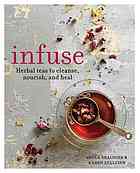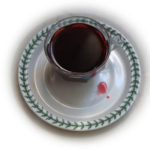
Infuse: Herbal Teas to Cleanse, Nourish, and Heal. / Paula Grainger and Karen Sullivan. Published by Hamlyn. An Hachette UK Company, 2016. 144 p., color illustrations, Herb-Pedia, Resources, Index.
Infuse: introduces freshly steeped herbs and spices in formulas that enhance your body and mind and their capacities to find relief, to feel better in your day to day life.
Some 112 herbs and spices are found in the book, in mixtures for infusions or decoctions, and many of these are likely new to you. Familiar are commonly known herbs such as St. John’s Wort, Echinacea, Peppermint and Ginger which are well-liked these days and known to provide comfort when nervous tension, immune response, and digestive issues strike. For sure, if you’ve ever counted on Peppermint tea for relief of stomach cramps or indigestion, you are not likely to forget about Peppermint—because it can be a godsend for stomach issues! Now with Infuse: Herbal Teas to Cleanse, Nourish, and Heal you can expand on that success with a large variety of herbal mixtures.
Once you’ve acquired the specific herbs listed, recipes are very manageable and easy to follow. Infuse: begins with a short list of herbs to keep on hand. There’s an introduction to brewing or infusing herbs and how to create your own mixtures or blends*, followed by chapters on detoxifying, digestive, energizing, calming, protective, and bliss-engendering tea mixtures. Finally, the authors reveal the secrets of magical blends and concoctions: herbal teas make chai, smoothies, mocktails and other frivolities you might relish once your herbal tea moxie gets fully charged!
Consider a common complaint we all have—diminishing energy! Especially when it’s been a stressful week, you need a break but you’re looking at a full schedule ahead, through to Sunday, entertaining, attending, volunteering, dinner with the dignitaries in your life, or just a whole lot to do and not much energy left after the week. Does it ever slow down? Sometimes not! and neither can you.
Where will you get the energy for every bit of it?
Why not refresh and renew your energy—try an herbal tea—not just any tea, but this special blend you’d brew yourself, or another tasteful and appealing blend from Infuse: Herbal Teas to Cleanse, Nourish, and Heal by Paula Grainger and Karen Sullivan.
—Vital Force Tea, with Siberian ginseng, ashwaganda root, holy basil, damiana leaf, fresh ginger root, and a dab of honey (if desired).
You might be tempted to try this blend that stars ginseng, ashwaganda, holy basil and damiana. All adaptogenic in action, they help strengthen us and restore energy when we feel weak. Fresh ginger is anti-inflammatory, anti-viral and invigorating.
Another daily concern is seasonal ups and downs. Look ahead into the fall/winter season and you might imagine this: it’s a cool day and your throat is beginning to get sore, your nose stuffy, and you have that dull, achy, heavy-body malaise that keeps you at home on a perfectly bright and sunny weekend. What to do? Make an herbal tea!—not just any herbal tea, but a specially crafted tea you’ve brewed yourself.
Be prepared for the seasons, stock your cupboard with mixtures for seasonal colds. Two suggestions from authors Grainger and Sullivan follow:
—Tea for a Head Cold, with echinacea root, elderberry, yarrow, peppermint, cinnamon bark chips, fresh ginger root, is just about guaranteed to alleviate cold symptoms. Familiar anti-viral medicinal, echinacea, is combined with ginger, elderberry leaves and cinnamon, is the perfect foil for a head cold, while yarrow combined with peppermint have antimicrobial properties.
Elderberries are from the Elderberry tree*: we see them first as a beautiful spray of white flowers, that after pollination, become dark blue shiny berries. Once dried, because they’re not good when ingested raw! they shrink to an intense almost black berry that when steeped in hot water casts a deep purple hue. Elderberries are anti-inflammatory and anti-viral fruits, mainstays in cold syrups, especially one available widely called Sambucus.
* The Botanical Name is Sambucus nigra. Don’t use flowers, leaves, fruit or bark, stems, etc. in fresh form as they are toxic, causing vomiting and diarrhea.

—Commuter Force Tea, with rosehips, elderberries, echinacea root, cinnamon bark, sage leaves.
The authors suggest chopped bark cinnamon, rather than ground cinnamon, and for good reason: ground cinnamon, a light powder, is difficult to combine properly with water and thus in tea. Ceylon Cinnamon sticks can be crumbled much easier than the darker, red-colored cinnamon sticks usually sold.
Like cooking a mixed vegetable dish, you want the pieces of herbs and spices roughly the same size and weight so their flavors infuse at the same time, mostly because Infuse: recipes suggest less steeping or brewing time.
Cinnamon added to rosehips, elderberries and Echinacea root, will mix up a blend of herbs and spices to strengthen your immunity.
Cinnamon bark and Elderberry are featured often in herbal medicine preparations like teas you brew at home for colds and flus, immunity, disagreements of the stomach and nervous system. They give us anti-inflammatory, antibacterial and antimicrobial constituents, and are made into commercial preparations such as cough syrups, and bag teas.
Cinnamon is great to have on hand for detox teas, balancing the blood sugar, keeping the digestive system moving, and as an ingredient in holiday punches and chai. Not the least of cinnamon’s great taste is simple Canela, cinnamon tea made from hot water and a stick of cinnamon—this brew needs no honey since it’s already sweet and endearing a taste on its own.
Why not make holiday brews and appealing new mixes that add herbal teas to familiar drinks? With its unusual ingredients Infuse: brings sparkling elegance to the concept of home brews.
Be prepared for the seasons, see Infuse: Herbal Teas to Cleanse, Nourish, and Heal for suggestions in stocking your cupboard with mixtures for the holidays, for seasonal colds, for blood sugar balancing, detoxifying, and improving digestion.
Infuse: Herbal Teas to Cleanse, Nourish, and Heal was created by herbalists Paula Grainger and Karen Sullivan and therefore sets a new standard. Photographs and delightful images are nothing short of enticing—there’s something sophisticated about its pages and you might purchase the book just on the merits of its charming good looks. Then, look out—an herb-savvy person—the new you, arises!
Follow


